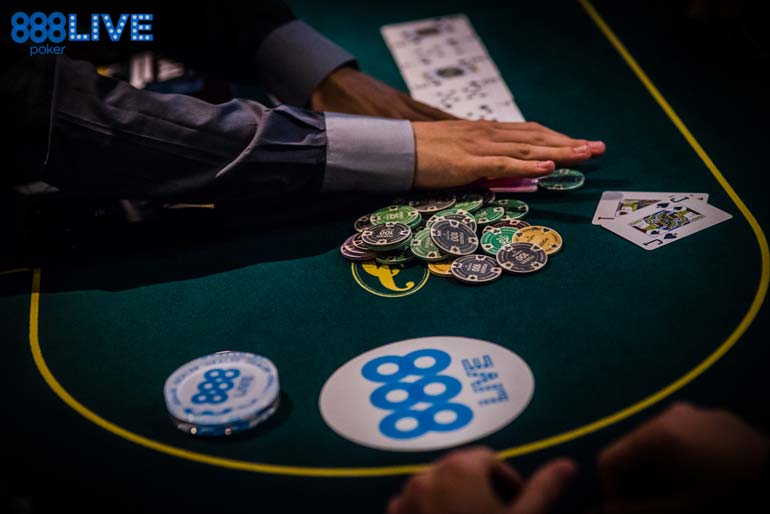Check-raise – Raising after already checking on the current street.
Check-raising in poker has long been considered a deceptive play. Why? Because we take a passive action at first (check), followed by an aggressive action (the raise).
Deceptive or not, check-raising constitutes a standard part of the game of poker. Knowing when to check-raise is essential for maximising our profits.
Here are some pointers for check-raising in poker.
Check-raising the Flop
The most common flop check-raise opportunity occurs when we are the cold caller out-of-position in a single-raised heads-up pot. We check to the preflop aggressor and have the chance to put in a check-raise after he fires a continuation bet.
In most cases, our check-raising ranges should be polarised - meaning that we raise a selection of value hands and draws.
Value Range – Typically two-pair plus (although it does depend on the effective stacks and the board texture).
Bluff Range – A selection of decent straight draws, gutshots, flush draws and backdoor equity type semi-bluffs but not total garbage.
The check-raise strategy must be weighted according to the specific opponent we are facing. In most cases, our opponent will either call too much or fold too much when facing the flop check-raise.
Calling Too Much (most frequent) – We should exclude some of the weaker bluffs from our check-raising range. Against many opponents, it is not necessary to check-raise backdoor equity. We can raise an overly strong range of flush draws, open-ended straight-draws and value hands. We can also slightly expand our value, check-raising range.
Folding Too Much – We should start bluffing more aggressively and with trashier hands. As a rough guide, if our opponent folds more than about 55% of the time to a 3x flop check-raise, we can check-raise any two cards as a bluff/semi-bluff.
Check-raising the Turn
Turn check-raise opportunities happen most frequently after we have check-called a flop continuation bet out-of-position. We are now facing a second barrel from our opponent on the turn.
Once again, our default strategy should be polarised.
Value Range – Usually top two-pair plus at this stage, but it again depends on the effective stacks and the board texture. Top two-pair might be too weak for a turn check-raise on specific boards.
Bluff Range – This play will involve relatively strong draws typically, such as open-ended-straight-draws, flush draws and some gutshots. The draws used as part of a turn check-raising range will not be quite strong enough to check/call usually. (If they are strong enough to check/call, they should be used as part of the turn check-calling range instead).
Once again, our turn check-raising strategy should be weighted based on the type of opponent we are facing.
Calls Too Much (Most Common) – We’ll either stick to very strong draws in our turn semi-bluff check-raising range. Or, we’ll just cut out all semi-bluffs entirely, check-raising a pure value range on the turn.
Folds Too Much – The more our opponent folds, the weaker the bluffs/semi-bluffs we can check-raise. Once our opponent starts folding above about 50% of the time to a 2.2x check-raise, we can think about potentially raising any two cards as a bluff/semi-bluff.
Check-raising the River

Similar to flop and turn check-raises, river check-raises should be polarised. There exists a crucial key difference between the type of polarisation we use on the flop and turn compared to the river, however.
The polarisation we employ on the flop and turn is not true polarisation (i.e. our absolute best and worst hands). We choose our best hands along with a selection of weaker hands that still have considerable equity (i.e. draws).
On the river, we now employ true polarisation where we take our absolute best and absolute worst holdings.
Absolute Best – Hands strong enough to check-raise on the river will depend on a number of variables such as –
- The exact action that has led to the river check-raise opportunity
- The effective stacks
- The board texture
- The type of opponent we are facing
However, if we were to generalise, we are typically looking at a check-raising range of sets and better. Even some sets won’t be strong enough to check-raise, however. It depends heavily on the board texture.
Absolute Worst – We should check-raise hands that have zero showdown value and could never win by calling, even if villain was bluffing. If a hand might sometimes win the pot by calling, it will be less of a candidate for check-raising typically. We are usually talking about high-card hands and worse. Although, it’s not impossible that we should sometimes be turning very weak pairs into check-raise bluffs.
At a very high level, we will consult card removal effects (AKA “blocker effects”) to determine which hands to check-raise. Against the vast majority of opponents, however, card removal effects will be irrelevant because our opponent will either clearly be folding too much or calling too much.
Calling Too Much – In this scenario, we cut out all of our bluff hands and raise a pure value range.
Folding Too much – In this situation, we start to bluff hyper-aggressively, but continue to raise our value range. (In some cases, we might value raise a little tighter to avoid value-owning ourselves).
Default Approach
The general advice for check-raising on any street is to “raise slightly stronger ranges than we should in theory”.
This strategy helps to naturally exploit the fact that most opponents don’t fold as often as they should to check-raises on any street.
By attempting to check-raise bluff hyper-aggressively against unknown opponents, we’ll frequently find ourselves running into a brick wall. Especially, when they don’t fold the hands that they should be folding.


